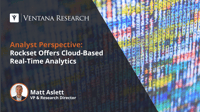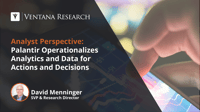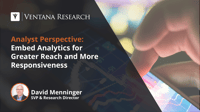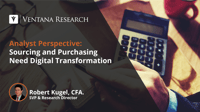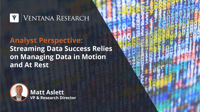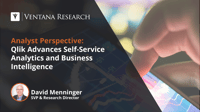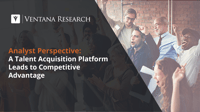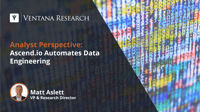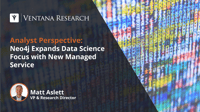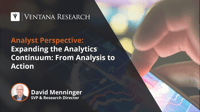The lockdowns of 2020 forced accounting departments to adapt to managing their close-to-report cycle without face-to-face contact, prompting many to adopt digital technologies to facilitate the process. It gave further impetus to the digital transformation of the department, which aims to eliminate unnecessary manual tasks such as consolidations and reconciliations using software automation. And, rather than looking at the close as a set of discrete tasks, Controllers and CFOs increasingly are...
Read More
Topics:
Office of Finance,
ERP and Continuous Accounting,
digital finance
I have written recently about increased demand for data-intensive applications infused with the results of analytic processes, such as personalization and artificial intelligence (AI)-driven recommendations. Almost one-quarter of respondents (22%) to Ventana Research’s Analytics and Data Benchmark Research are currently analyzing data in real time, with an additional 10% analyzing data every hour. There are multiple data platform approaches to delivering real-time data processing and analytics...
Read More
Topics:
Cloud Computing,
Data,
Streaming Analytics,
Analytics & Data,
Streaming Data & Events,
operational data platforms,
Analytic Data Platforms
Organizations are managing and analyzing large datasets every day, identifying patterns and generating insights to inform decisions. This can provide numerous benefits for an organization, such as improved operational efficiency, cost optimization, fraud detection, competitive advantage and enhanced business processes. By bringing the right, actionable data to the right user, organizations can potentially speed up processes and make more effective operational decisions.
Read More
Topics:
embedded analytics,
Business Intelligence,
Internet of Things,
Streaming Analytics,
AI & Machine Learning
Especially in the United States, baby boomer retirements and fewer graduates with accounting degrees is posing a growing challenge to finance department executives in attracting and retaining the best accounting talent. The solution, which may not seem obvious, is to make accounting cool, again.
Read More
Topics:
Office of Finance,
Financial Performance Management,
ERP and Continuous Accounting,
digital finance
It has been nearly two and a half years since the world was thrust into one of the most dramatic eras of workforce transformation in the modern era. Organizations have been forced to reevaluate everything about the workforce, from the physical spaces in which work is done, to compensation, to non-traditional benefits and work/life enhancement offerings. Even so, many continue to struggle to attract and retain the right talent to support operational needs. As leaders continue to redesign how...
Read More
Topics:
Human Capital Management,
Talent Management
When I looked at the state of analytics recently, it was clear that analytics are not as widely deployed within organizations as they should be. Only 23% of participants in our Analytics and Data Benchmark Research reported that more than one-half of their organization’s workforce are using analytics. There are many elements to becoming a data-driven organization, as my colleague Matt Aslett points out, but analytics are a necessary component. Our research shows that organizations recognize the...
Read More
Topics:
embedded analytics,
Analytics,
Analytics & Data
“Digital finance transformation” became an even more important topic over the past two years as finance and accounting departments have had to cope with an unrelenting set of new challenges that have had a profound impact on business operations, financial markets and regulatory environments. Digital technologies enable organizations to cope with change and improve performance by increasing efficiency, reducing risk, achieving greater visibility into opportunities, shortening process cycles and...
Read More
Topics:
Office of Finance,
Financial Performance Management,
ERP and Continuous Accounting,
digital finance
I recently noted that as demand for real-time interactive applications becomes more pervasive, the use of streaming data is becoming more mainstream. Streaming data and event processing has been part of the data landscape for many decades, but for much of that time, data streaming was a niche activity. Although adopted in industry segments with high-performance, real-time data processing and analytics requirements such as financial services and telecommunications, data streaming was far less...
Read More
Topics:
Big Data,
Data,
Streaming Analytics,
Analytics & Data,
Streaming Data & Events
The analytics and business intelligence market landscape continues to grow as more organizations seek robust tools and capabilities to visualize and better understand data. BI systems are used to perform data analysis, identify market trends and opportunities and streamline business processes. They can collect and combine data from internal and external systems to present a holistic view.
Read More
Topics:
Analytics,
Business Intelligence,
Data Governance,
Data Management,
AI & Machine Learning,
Analytics & Data
The applicant tracking system, for all its shortcomings, revolutionized the way people found and applied for jobs when it first hit the market in the mid-1990s. Electronic applications quickly became the norm, resume or application review became more accessible for hiring teams and compliance was much more trackable and achievable, thanks to streamlined application processes. Today, tracking and compliance aren’t enough to power the complex world of recruitment. The Great Resignation has made...
Read More
Topics:
Human Capital Management,
Talent Management
Anaplan offers a cloud-based business planning platform that incorporates a modeling and calculation engine. The tool makes it relatively easy to add or expand the scope of plans that can be connected and monitored on a single platform. This Integrated Business Planning (IBP) approach enables organizations to use the software for financial planning or budgeting, sales, supply chain, workforce, marketing and IT planning. These are the types of plans in which companies often need to create models...
Read More
Topics:
Office of Finance,
Continuous Planning,
Business Intelligence,
Business Planning,
Financial Performance Management,
continuous supply chain,
digital finance,
AI & Machine Learning,
profitability management
I have recently written about the importance of healthy data pipelines to ensure data is integrated and processed in the sequence required to generate business intelligence, and the need for data pipelines to be agile in the context of real-time data processing requirements. Data engineers, who are responsible for monitoring, managing and maintaining data pipelines, are under increasing pressure to deliver high-performance and flexible data integration and processing pipelines that are capable...
Read More
Topics:
Big Data,
Cloud Computing,
Data Management,
Data,
data operations
The contact center industry is reexamining how organizations engage with contact center agents. One thing that we learned from the forced movement to work-from-home was that organizations have to provide agents with appropriate tools to collaborate and communicate with peers and supervisors as well as workers in the back office who participate in all sorts of customer-facing or customer-adjacent processes. It is also important to provide supervisors with visibility into agent activity. That...
Read More
Topics:
Customer Experience,
Voice of the Customer,
Contact Center,
agent management,
Customer Experience Management,
Field Service,
customer service and support
I recently explained how emerging application requirements were expanding the range of use cases for NoSQL databases, increasing adoption based on the availability of enhanced functionality. These intelligent applications require a close relationship between operational data platforms and the output of data science and machine learning projects. This ensures that machine learning and predictive analytics initiatives are not only developed and trained based on the relationships inherent in...
Read More
Topics:
Business Intelligence,
Data,
AI & Machine Learning,
operational data platforms,
Analytic Data Platforms
Environmental, social and governance issues have grown increasingly pressing over the past few years as investors and government entities urge organizations to measure and disclose ESG metrics. I’ve already covered the broader topic as it relates to external reporting and how financial planning and analysis groups are likely to own this mandate going forward. (It’s mainly been a marketing and public relations effort up to now.) FP&A departments are also likely to be charged with responsibility...
Read More
Topics:
FP&A,
Office of Finance,
ESG
I often use the term “analytics” to refer to a broad set of capabilities, deliberately broader than business intelligence. In this Perspective, I’d like to share what decision-makers should consider as they evaluate the range of analytics requirements for their organization.
Read More
Topics:
Business Intelligence,
natural language processing,
Streaming Analytics,
AI & Machine Learning,
Analytics & Data

